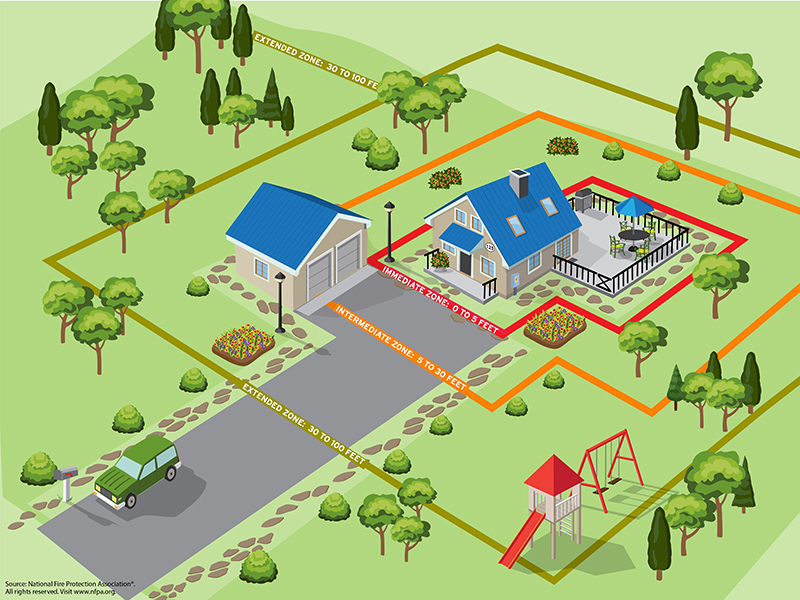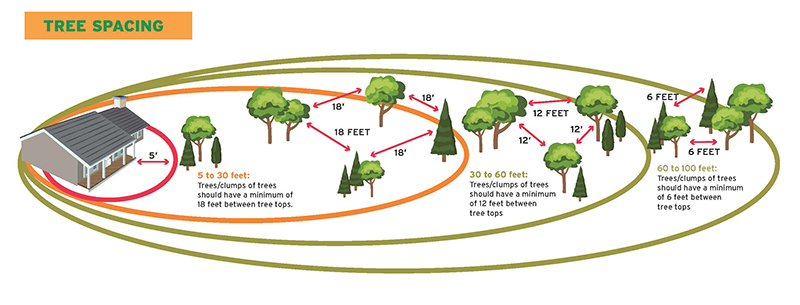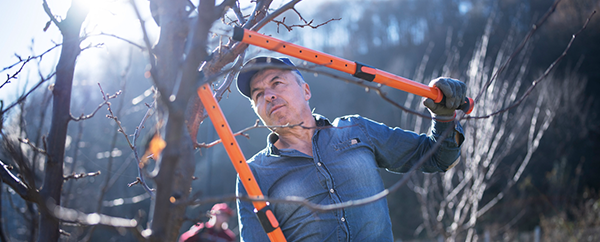Help your clients protect their property with these essential wildfire mitigation steps
- Whether for home or business, creating defensible spaces around your property is key to wildfire mitigation. Focus on clearing flammable materials, maintaining roofs and gutters and using hardscapes to slow fire spread.
- Homeowners: keep an emergency go-bag ready and evacuation routes prepared. Businesses: ensure an evacuation plan is in place, regularly train employees and keep emergency equipment ready.
- Always have an up-to-date insurance policy that covers wildfire damage and document your property thoroughly. Being prepared for the worst can make recovery easier, whether you’re a homeowner or a business owner.
A year-round threat
The trend is clear: wildfires are no longer just a seasonal concern — they’re a year-round reality. Although wildfire season has varied from state to state, in the past we could expect fires in the western U.S. during the summer and fall, and during the spring in the Midwest. However, driven by changes in both the climate and land use, historical wildfire patterns are becoming increasingly irrelevant as they continue to occur more frequently and unpredictably. In fact, according to the National Interagency Fire Center and as of the date of publication, there have been 30,866 wildfires so far this year, which have burned more than 5.4 million acres year-to-date. Unfortunately, the threat is here to stay. But the good news is, whether you’re ahead of the game or feel like you’re playing catch up, it’s never too early — or too late — to help your clients protect their properties, and for you to protect your own. To help, we’ve developed this comprehensive guide to help you prepare for and mitigate wildfire risks. Let’s dive in, shall we?
The home ignition zone
Research shows that it’s not the big flames you need to worry about most — it’s the embers. These tiny firebrands can fly over a mile in the wind, starting spot fires and setting homes ablaze. The area up to 200 feet of your home, called the Home Ignition Zone, is the most crucial in determining whether a home will ignite.
The HIZ is split into three zones, each needing its own specific mitigation steps to reduce wildfire risk.

Protecting your home: A zone-by-zone breakdown
Immediate zone (0-5 feet)
The immediate zone is where the stakes are highest; it’s the most critical area to defend against embers. So, in general, it’s a good idea to start with your house and work your way out. Regular maintenance and the following fixes can make a significant difference in this zone.
- Keep the roof and those gutters clean. Dead leaves and pine needles are kindling for embers.
- Fix any loose shingles or tiles. You don’t want embers sneaking in through the roof.
- Cover attic vents with 1/8-inch metal mesh. You can think of the mesh as a bouncer for embers trying to get into the hottest club in town: your attic.
- Check your windows and screens, then repair or replace any that are damaged.
- Don’t forget the space under your deck and your patio. Consider screening or boxing-in these areas with wire mesh to prevent debris from piling up.
- Move anything flammable away from your walls. This includes mulch, plants and firewood, as well as anything stored underneath decks or porches.
Intermediate zone (5-30 feet)
Here’s where landscaping and hardscaping come into play. Thoughtful planning and regular maintenance in this zone can greatly enhance your property’s resilience to wildfires.
- Clear vegetation from under propane tanks. It’s just common sense.
- Use your driveway, walkways and patio as natural firebreaks. These can slow down the spread of the fire long enough to provide clear access to firefighters.
- Keep your lawn short — no higher than four inches. This includes native grasses.
- Trim those trees. Remove lower branches (i.e. ladder fuels) up to 6-10 feet from the ground to prevent a surface fire from reaching the tree crowns.
- Space your trees out. To prevent the likelihood of a fire spreading from tree to tree, aim for at least 18 feet between crowns, with the distance increasing with the slope percentage.
Extended zone (30-100 feet, up to 200 feet)
This is your last line of defense. The goal in this zone is to interrupt the fire’s path and keep flames smaller and on the ground.
- Clear out dead plants and trees. They’re just fuel for the fire.
- Manage the growth of your trees. Keep an eye on those little conifers growing between bigger trees.
- Don’t forget your sheds and outbuildings. Keep vegetation away from them, too!
- Space out your trees here as well. The suggested guideline is 12 feet between crowns of trees 30-60 feet away, and 6 feet for those 60-100 feet out.

Prepare for the worst
It’s hard to think about, but no matter how diligently you prepare and how many mitigation techniques you implement, the reality is that wildfires can be unpredictable and devastating. That’s why it’s crucial to prepare for the worst-case scenario — because when the stakes are this high, being ready can make all the difference. Some steps you could take to prepare are:
- Have an emergency go-bag packed and easily accessible. This bag should include essentials like water, non-perishable food, medications, clothing and basic first aid supplies. The goal is to be ready to leave at a moment’s notice with supplies that will help you stay safe and survive.
- Take time to develop a clear evacuation plan, and make sure every family member knows it by heart. Map out multiple escape routes, designate a meeting point and consider where you would go if you needed to evacuate. Practicing this plan regularly can help ensure that everyone stays calm and focused during a real emergency; don’t skip this step.
- Remember the six Ps of evacuation: People/pets, papers (i.e. important documents), prescriptions, priceless items, personal computers, and plastic (i.e. credit cards, ATM cards and cash). Having these essentials in mind can help prioritize what matters most when every second counts.
- Check your insurance in advance. Make sure your property and belongings are adequately covered in the event of a wildfire. Understanding what’s included and making any necessary updates to your coverage now can save you a lot of stress and financial hardship later.
Related: Top homeowners’ risks (and tips on how to lower them)
Protecting your business: Creating a defensible space
If you run a business, you’ve got a different set of challenges. Start by sizing up your risk. Take a good look at the vegetation around your building. What’s out there that could burn? Make sure to consider how a fire moves: climbing from the ground to shrubs to treetops or rooflines and vice versa in no time. This understanding can help you plan effective firebreaks and defensive measures.
Related: Wildfire safety tips for businesses
Within 30 feet:
- Clear out anything that can burn. This includes vegetation, firewood, outdoor furniture and other combustible materials to reduce immediate fire risk.
- Keep your roof and gutters clean. Yes, it seems basic, but it could save your business. Regular cleaning is crucial in this high-risk zone.
- Trim those trees. And when possible, use native, drought-resistant plants.
30-100 feet out:
- Use stone or gravel walkways as firebreaks. It’ll look good and serve a purpose.
- Keep any outbuildings at least 50 feet away, especially if they store flammable goods. Proper placement can prevent these structures from becoming ignition points.
- Prune and plant fire-resistant vegetation. At the risk of sounding like a broken record, it’s essential to keep maintaining the trees and plants around your property. Regular upkeep can significantly lower fire hazards.
Beyond 100 feet:
- Keep your vegetation healthy. Regularly prune and remove dead or dying branches.
- Clear out dead stuff from the ground. It’s just waiting to burn.
Additional precautions for businesses
Homeowners and business owners can face similar challenges with it comes to wildfire mitigation. However, managing a business introduces another layer of complexity, especially when employees are involved. So, in addition to the property preparedness tips above, consider the following steps:
- Have a solid evacuation plan. And make sure everyone knows it. It should include activation conditions, chain of command and specific routes and exits.
- Keep emergency equipment handy and working. This includes personal protective equipment and firefighting tools.
- Train your workers regularly. Those fire drills really matter! Make sure to update your plans and procedures based on lessons learned during drills.
- Know what to do with hazardous materials. Follow the Occupational Health and Safety Administration’s guidelines for emergency response involving hazardous substances.
- Review and update your insurance policies. Having the correct commercial coverage that covers wildfire-related damages can provide financial protection and peace of mind in the event of a disaster.
No approach is infallible, but implementing these strategies can significantly enhance your business’ resilience against wildfires, ensuring the safety of both your employees and your assets.
Related: Steps for business recovery after a wildfire
The bottom line
Protecting your property from wildfires isn’t a one-and-done deal. It’s something you and your clients must stay on top of year-round. But by following these steps, you can give your home and / or business a fighting chance against wildfires. After all, it’s all about being proactive and staying prepared. Don’t forget that.
For more details, check out NFPA’s Firewise or CalFire’s Defensible Space guide.
References:

